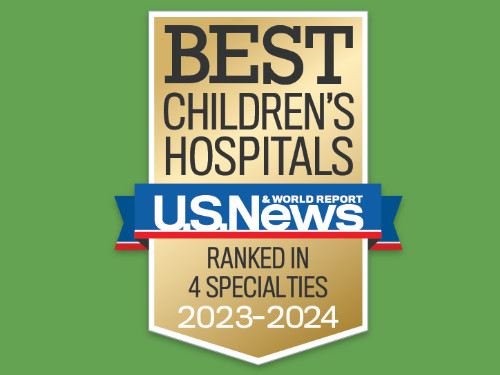What Is Pediatric Hydrocephalus?
Hydrocephalus comes from the Greek: hydro means water, cephalus head. Hydrocephalus is an abnormal accumulation of fluid (cerebrospinal fluid, or CSF) within cavities called ventricles inside the brain. CSF is produced in the ventricles by delicate tufted structures known as choroid plexus. It circulates through the ventricular system and is absorbed into the bloodstream.
CSF is in constant circulation and has many important functions. It surrounds the brain and spinal cord and acts as a protective cushion against injury. CSF contains nutrients and proteins that are needed for the nourishment and normal function of the brain. It also carries waste products away from surrounding tissues. Hydrocephalus occurs when there is an imbalance between the amount of CSF that is produced and the rate at which it is absorbed. As the CSF builds up, it causes the ventricles to enlarge and the pressure inside the head to increase.
What Causes Pediatric Hydrocephalus?
Hydrocephalus that is congenital (present at birth) is thought to be caused by a complex interaction of genetic and environmental factors. Aqueductal stenosis, an obstruction of the cerebral aqueduct, is the most frequent cause of congenital hydrocephalus. Acquired hydrocephalus may result from spina bifida, intraventricular hemorrhage, meningitis, head trauma, tumors and cysts. Hydrocephalus affects about one in every 500 children born.
How Is Pediatric Hydrocephalus Treated?
There is no known way to prevent or cure hydrocephalus. The most common treatment for pediatric hydrocephalus is surgical implantation of a shunt, which contains a flexible tube and valve system to drain the excess CSF from the brain into another part of the body, such as the abdomen, where is can be absorbed into the bloodstream. Some patients may be candidates for a minimally invasive surgical procedure called endoscopic third ventriculostomy (EVT). This treatment option is typically available for patients with an obstruction between the third and fourth ventricles of the brain, which prevents the flow of CSF. EVT provides an alternate channel for the fluid to bypass the obstruction.
The team of physicians at the Children’s Neuroscience Center is nationally recognized for innovative endoscopic treatments for pediatric hydrocephalus that go beyond EVT. Pediatric neurosurgeons affiliated with Children’s Memorial Hermann Hospital are extensively experienced in using minimally invasive techniques, including:
- Septostomy
- Aqueductoplasty
- Choroid plexus coagulation
- Cyst fenestration
Ventriculoperitoneal Shunt
VP is a surgery that is performed when a buildup of fluid on the brain and spinal cord is diagnosed. During the procedure, excess fluid is drawn off from inside the head down to the belly or heart in order to relieve pressure on the brain tissue.
A VP shunt is performed in an operating room under general anesthesia. Your child’s hair behind the ear or head will be shaved off and two incisions will be made – one behind the ear or head and another in your child’s belly. A small hole will be drilled in the skull and a catheter (small thin tube) will be passed into a ventricle of the brain. Another catheter will be placed under the skin from behind the ear or head, down the neck and chest, and will usually go to the abdominal cavity, although sometimes it may go to the heart. A fluid pump or valve placed underneath the skin behind the ear or head then will be attached to both catheters. The pump will “shunt” or draw off the excess cerebrospinal fluid into the abdominal or chest cavity.
Any operation, no matter how safe, has its risks. The three main complications for VP shunt, all of which are rare, include an infected shunt, a blocked shunt and internal bleeding after the procedure. On occasion, the shunt also may stop working and fluid will begin to build up in the brain again, or the brain may swell, bleed or become infected, resulting in damage to the brain tissue. Our caregiver team will work to minimize these risks by providing the highest level of care possible during your child’s stay.
The average hospital stay following this procedure is three to four days. During that time, your child will be given intravenous fluids and antibiotics, monitored closely for vital signs and neurological status, and may receive medication for pain. Physicians also will check the shunt regularly to ensure it is working properly.
What Are the Effects of Pediatric Hydrocephalus?
Since the advent of shunting over forty years ago, the outcome for most children with hydrocephalus is optimistic. Some children with hydrocephalus will have less than normal intelligence, physical disabilities and a variety of other medical problems. Shunt malfunctions and infections, developmental delays, learning disabilities and visual problems are not uncommon. Families need to be aware of the life long complexities of hydrocephalus to insure their children receive comprehensive on-going care and appropriate intervention services and therapies.
Contact Us
If you have any questions, use the online tool below to help us connect with you. To refer a patient or schedule an appointment, please contact our clinic using the information below.
- Pediatric Stroke Clinic
UT Professional Building
6410 Fannin, Suite 500
Houston, TX 77030
P: (713) 500-7164 - Pediatric Neurosurgery Clinic
6410 Fannin Street, Suite 950
Houston, TX 77030
P: (832) 325-7234 - UTHealth Houston Gulf State Hemophilia and Thrombophilia Center
6655 Travis Street, Suite 100
Houston, TX 77030
P: (832) 325-7242
To contact Children's Memorial Hermann Hospital, please fill out the form below.
